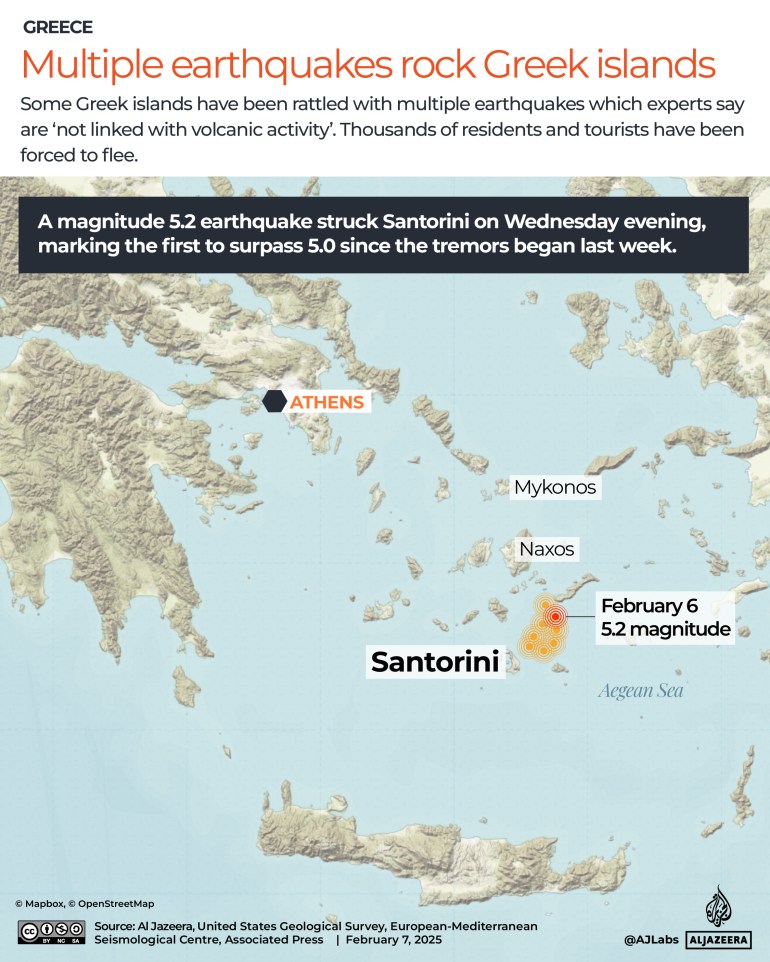Following days of persistent tremors, Santorini, Greece, experienced its strongest earthquake.
On Wednesday night, a magnitude 5. 2 earthquake, the first of its kind to hit the island since tremors started last week, struck Santorini. On Thursday, two larger tremors jolted the island, each exceeding a magnitude of 4.0.
Santorini’s last major earthquake, a magnitude 7.5 tremor in 1956, killed at least 53 people.
What we currently know is as follows:
What is happening in Santorini?
The island, one of Greece’s Cyclades islands in the Aegean Sea, has been experiencing near-constant tremors since January 27, 2025, with thousands of earthquakes recorded so far.
The strongest earthquake recorded on Wednesday evening, which was felt on the evening, had a magnitude of 5.2.
The magnitude of an earthquake is determined using decimal points, which represent its increments. An earthquake of magnitude 6.0 or higher is classified as severe, while a magnitude of 5.2 is considered moderate.
Santorini is located along the Cyclades islands’ extension, which starts in southern Greece and ends in the Peloponnese. The region is also home to two volcanoes: Nea Kameni, a small islet within Santorini’s caldera, and Kolumbo, an underwater volcano located approximately eight kilometres (five miles) northeast of the island.
The Santorini-Amorgos earthquake swarm just keeps going. Since its debut on January 27th, it has now produced over 1, 000 individual events. twitter.com/KQwxEj0Vbb
Where are Santorini’s earthquake epicenters located?
The earthquake epicentres are concentrated in a growing cluster between Santorini, Anafi, Amorgos and Ios islands. Between Santorini and the nearby island of Amorgos, there is still a lot of seismic activity.
The epicentres are located beneath the seabed, which is good news, according to scientists, land-based earthquakes generally cause greater destruction. Even though Greece is a seismically active nation, earthquakes are not uncommon.
What are the main concerns?
Authorities are making preparations for an even bigger earthquake because the tremors are still not abating. On Wednesday, authorities warned of landslide risks to parts of the island.
According to Vassilis K. Karastathis, a seismologist and director of research at the National Observatory of Athens, “we are not yet in a position to say that we are seeing any evidence that would lead to the sequence gradually coming to a conclusion.”
“We are still in the middle of the road, we haven’t seen any easing, any sign that it’s heading towards a regression”.
Neither major damage nor injuries have been caused by the earthquakes. According to reports, more than 11, 000 people have departed from Santorini as a result of the tremors. According to the 2021 census, Santorini, which is popular with tourists, has a permanent population of 15, 000.
Could the earthquakes cause a volcanic eruption?
Although Santorini is in close proximity to two volcanoes, experts consider an eruption unlikely. According to scientists, the earthquakes of today are unrelated to volcanic activity and don’t pose a particular risk.
Last week, Greece’s Ministry of Climate Crisis and Civil Protection reported that sensors detected “mild seismic-volcanic activity” within Santorini’s caldera. A similar event in 2011 persisted for 14 months without causing any volcanic issues, however.
“At this moment, I don’t think there is any hazard from the submarine volcano of Kolumbo and the volcanic complex … however, I should say that we cannot exclude the arrival of a second pulse of magma, and]if so] this episode will repeat”, Athanassios Ganas, research director of the National Observatory of Athens, told Al Jazeera.
The island does have a long history of volcanic activity, however. Santorini developed into its present geological form at around 1,600 BC as a result of one of the largest volcanic eruptions in human history.
The island experienced significant seismic activity between 2011 and 2012 as a result of magma movement beneath the surface.

Will the tremors last forever or will they get worse?
According to Ganas, “we cannot exclude the possibility of an earthquake affecting one of the neighboring faults of magnitude 6. 0.”
“Because all these seismicity transfer stresses to neighbouring faults that are long enough, about 15 kilometres, and this fact means that they have the potential for a magnitude 6.0 earthquake”, he added.
However, Ganas emphasised this is not the most likely scenario. “This is the second one in priority. He said that the first scenario is that there is a seismic swarm in the area.
A seismic swarm is a series of brief, time-varying, hours to months-long, mostly dominant mainshocks that occur in a localized area.

How are Greek authorities responding?
On Friday, Greek Prime Minister Kyriakos Mitsotakis is scheduled to travel to Santorini.
Santorini and Amorgos’ schools were closed until Friday, and local authorities sent rescuers to the area, and they warned people to stay away from ports and gatherings inside.
Source: Aljazeera

Leave a Reply